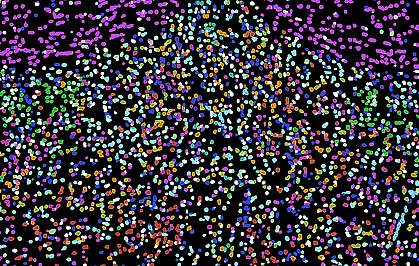You are here
November 20, 2018
Building an atlas of brain function in mice
At a Glance
- Researchers produced an atlas of brain cells in a region of the mouse hypothalamus that controls key social behaviors.
- The approach could let scientists map other parts of the brain to better understand how its organization underlies behavior and health.

The brain is an incredibly complex organ. Many parts of the body, like the liver, have a symmetrical structure. The brain, in contrast, is a complicated jumble of cell types that interact in intricate ways, making it much more difficult to study. If scientists could map the structure and function of different parts of the brain, it would help them better understand its diseases and disorders.
Researchers led by Drs. Catherine Dulac and Xiaowei Zhuang of Harvard University set out to understand how brain cells, or neurons, are organized in mice in an area of the brain called the preoptic region of the hypothalamus. This part of the brain controls important social behaviors, including parenting, mating, and aggression. It also helps regulate basic needs such as thirst and sleep.
The team first used a tool called single-cell RNA sequencing in tissue samples taken from the mouse preoptic region. Single-cell RNA sequencing can identify genes that are turned on, or “expressed,” in a cell. This provides information on what individual neurons do. But cells must be removed from the surrounding tissue to use this technique. Therefore, it can’t provide information on how neurons are physically organized.
To see the spatial organization of cell types, the researchers used a technique called MERFISH. In MERFISH, RNAs for different genes are assigned unique barcodes. The barcodes are detected using multiple fluorescent probes. This approach allows individual RNA molecules to be identified and localized within cells in intact tissue. The expression profiles of the individual cells reveal how they are organized in space.
The researchers combined these techniques to create a “cell atlas” of regions of the brain that shows both the function and structure of groups of neurons. The work was funded in part by NIH’s National Institute of Mental Health (NIMH) and others. Results were published on November 16, 2018, in Science.
By combining their MERFISH data and single-cell RNA data, the team identified about 70 sets of neurons in the hypothalamus with different RNA expression profiles, spatial organizations, and functions, such as sensing warmth and detecting hormones.
To determine which neuronal populations are involved in specific social behaviors, the researchers used MERFISH to probe brain tissue immediately after observing parenting, mating, or aggressive behaviors in mice. For each behavior, MERFISH showed high activity in different clusters of neurons. This suggests that different groups of neurons in the preoptic region help regulate these different behaviors. MERFISH also showed that different sets of neurons were active during parenting behaviors in male and female mice.
This combination of laboratory techniques gives a view of the cellular, molecular, and functional organization of the brain. “Nobody had combined those three views before,” Dulac says. “We now understand several behaviors in ways that we never did before.”
The researchers are planning to use these techniques to investigate how groups of neurons in the hypothalamus communicate with each other. The approach could also be applied to study cell populations involved in other behaviors or brain disorders.
Related Links
- Mental Disorders May Share Molecular Origins
- An Atlas of the Developing Human Brain
- Landscape of Gene Expression in the Human Body
- NIH’s BRAIN Initiative
References: Molecular, spatial and functional single-cell profiling of the hypothalamic preoptic region. Moffitt JR, Bambah-Mukku D, Eichhorn SW, Vaughn E, Shekhar K, Perez JD, Rubinstein ND, Hao J, Regev A, Dulac C, Zhuang X. Science. 2018 Nov 16;362(6416). pii: eaau5324. doi: 10.1126/science.aau5324. Epub 2018 Nov 1. PMID: 30385464.
Funding: NIH’s National Institute of Mental Health (NIMH), Eunice Kennedy Shriver National Institute of Child Health and Human Development (NICHD), and National Eye Institute (NEI); Klarman Cell Observatory; and Howard Hughes Medical Institute.
